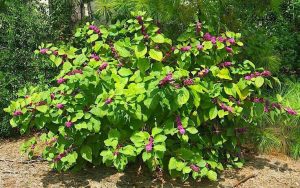By Debbie Roland and
Emmy Ulmschneider
Master Gardeners
I am on a quest for three American Beautyberry bushes (Callicarpa Americana). I saw them growing at a restaurant in the Hill Country last year and haven’t been able to quit thinking about them. I don’t see them very often here but my hunt has begun. Here is some info just in case you want to join in the hunt.
American Beautyberry also called French Mulberry is a Texas native deciduous shrub. It often grows in places from dry to moist and full sun to shade, although it seems to do best in our area with a small amount of shade.
This shrub can grow up to 6’ tall and 6’ wide although I find that most things don’t quite reach the height or width on the tag in our dry, hot climate. It is multi-stemmed and has toothed green foliage. Pay attention because the leaves are large and can hide the blooms. These blooms grow in clusters and have showy white to pink flowers along the nodes which will appear in July. Typically this plant will not leaf out until late April so don’t give up on it too early. In September the fruit will appear and continue through November when they just shrivel into raisins. The berries are a bright fuchsia color and are really quite beautiful.

If, like us, your goal is to get wildlife into your yard and garden, this plant is the one to do it. Birds love the berries and later the raisins. Gray foxes, squirrels, raccoons will all flock in, as well as white tail deer. Occasionally deer will bed down in the bushes since they have an ability to repel insects. This plant has been a folk remedy for shooing away biting insects in the southeast United States since the 1800s. More recently studies have shown that the leaves contain terpenoids that repel fire ants.
When eaten directly off the bush the berries are bitter but they do make a great jelly. It has been said that it tastes somewhat like elderberry. If you don’t want to make jelly the berries look pretty in dried arrangements.
American Beautyberry adds color to your yard or garden and is especially pretty when planted in a native landscape. It is easily propagated by seed or cuttings. Birds are known to spread the seeds around and these can easily be transplanted to other more desirable parts of your yard. Try planting them in a container as well. Fall is the best time transplant. Prune to the ground in winter or early spring.
The good news is that it is heat tolerant and can survive a hard drought once established. They will also persevere through a freeze and snow. This plant is worth looking into for your landscape.
If you have questions, call the AgriLife office in Odessa at 498-4071 or in Midland at 686-4700. Additional information, and our blog for access to past articles, is available at westtexasgardening.org. Click on “Resources.”




